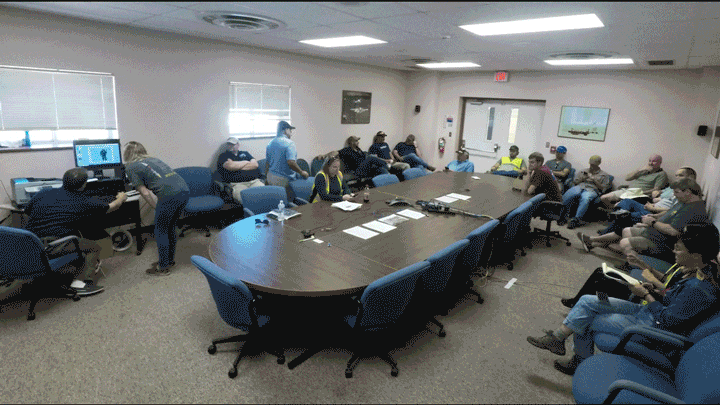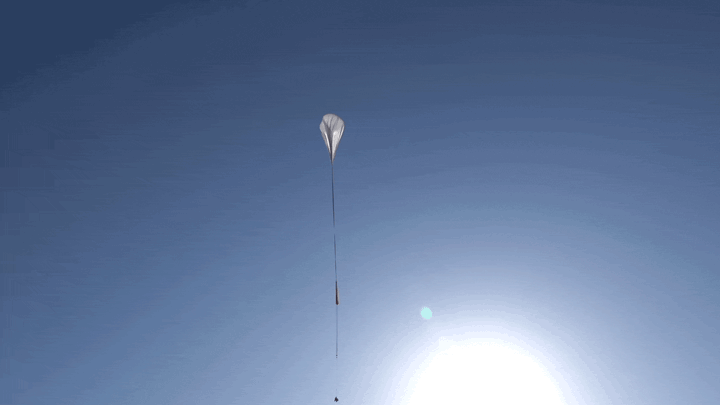It’s 1:30 p.m. MT, and scientists and engineers at NASA’s Columbia Scientific Balloon Facility’s field site file into a meeting room. Time for the weather briefing. It’s standing room only — the biggest group of people I’ve seen yet in my week in Fort Sumner, New Mexico, population roughly 1,000.
Daily weather briefings give rhythm to otherwise irregular days filled with launch attempts and instrument tests. Everyone is here to send balloons to the top of the sky; this daily meeting is where the decisions are made about whether we’ll try to do it the next morning. Since launch preparations begin around 2 a.m., this is when I learn whether I need to set my alarm for 12:30 a.m., six hours earlier than usual.

I’m a NASA writer, here with a team of scientists and engineers launching a solar scope called BITSE, which is testing a new way to see the Sun. BITSE — short for Balloon-borne Investigation of Temperature and Speed of Electrons in the corona — is a coronagraph, a kind of instrument that peers at the Sun’s dim atmosphere, the corona. BITSE will search for clues to how the solar wind, the stream of charged particles constantly blowing from the Sun, forms there.
To me, it seems the most challenging thing about launching scientific balloons is the weather. It has to be just right in an entire chunk of sky: from the ground where the balloon launches, through the long stretch of blue where it ascends, to some 22 miles up where it floats. The balloon also needs consistent winds and fair skies along its projected flight path, which spans hundreds of miles and changes every day — depending on the weather, of course.
“Basically, we can’t have wind at the surface when we lay out the balloon,” NASA mission manager Amy Canfield explained. “Then, when the balloon is inflated, we want light low-level winds, so the balloon ascends nice and calm, straight up. The weather can change just like” — she snapped — “that. If it changes, we have to scrub for the day.”

In Fort Sumner, a town in the desert 4,000 feet above sea level, late summer is hot, and the wind blows like a hair-dryer on low. Fort Sumner, which sits in the waist of New Mexico, is well-positioned for balloon launches. It’s remote, about an hour drive to the next town in any direction. Ascending balloons aren’t likely to stray too far north into the Rocky Mountains or too far south into Mexico.

BITSE passed its final test before launch, so now we’re just waiting for good weather. Waiting each day to learn whether BITSE will get a chance to fly that night is nerve-wracking. One of the scientists on the team likened our seemingly endless wait to life in the movie Groundhog Day.
Several times, thunderstorms hundreds of miles away kept BITSE grounded. The air above a thunderstorm is cold, so when a balloon passes overhead, you get balloon droop. The helium inside shrinks from the chill and the balloon plunges — bad news for the team if that cuts the flight short or drops BITSE into a rough storm.
Another time, had BITSE launched, the winds would have carried it on a grand tour of pretty much every population center between Fort Sumner and eastern Arizona, which safety regulations won’t permit. Often, gusting winds on the ground prevented smooth unrolling of the balloon. “If you feel wind blowing in your face, we’re not launching a balloon,” NASA mission operations manager Andy Hynous said.
The balloon program in Fort Sumner also takes advantage of what’s called the Turnaround — a stratospheric weather pattern that has the upper atmospheric winds blowing east to west the first half of the year and west to east in the second. Each fall balloon campaign takes place during the last weeks of east-to-west winds, just before the Turnaround. They send balloons west, into a part of the country where there are vast swathes of open, uninhabited land.
The meteorologist working on the balloon campaign says most other meteorologists don’t care what happens in the stratosphere since it doesn’t touch our lives, far below. But for science instruments, the region offers the chance to show their mettle above most of Earth’s atmosphere. Scientists gain access to measurements and tests they can’t do on ground-based instruments. For BITSE, flying 22 miles up means studying the Sun’s dim atmosphere with much less interfering light than it would experience from the ground. The flight could also pave the way for an instrument descendant of BITSE’s to potentially do the same science from space one day.
After the weather update, NASA mission range safety officer Lauren Morgan presents her assessment of risks in the projected flight path. Besides good weather, BITSE also needs a thumbs-up from safety to fly. She considers a number of factors to ensure a safe flight. How many towns or cities would the balloon fly over? Which airports need to be alerted? Then, at the end of the flight, when BITSE parachutes down, she’ll consider whether the recovery team — which meets BITSE and brings the 6,000-pound load back to Fort Sumner — can safely drive into potential landing spots. She wants to avoid towns and cities, national parks and wilderness areas, public infrastructure like wind farms, and even the delicate habitats of endangered species.
Day by day, the team will keep presenting new forecasts and projections, searching for a window just right for BITSE’s flight. Until then, the only thing for us to do is keep waiting for the winds to align.





We will be watching for the balloon as it passes by central New Mexico!